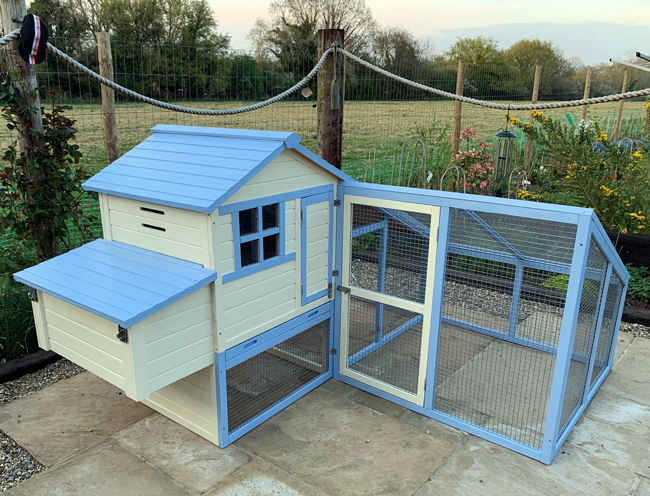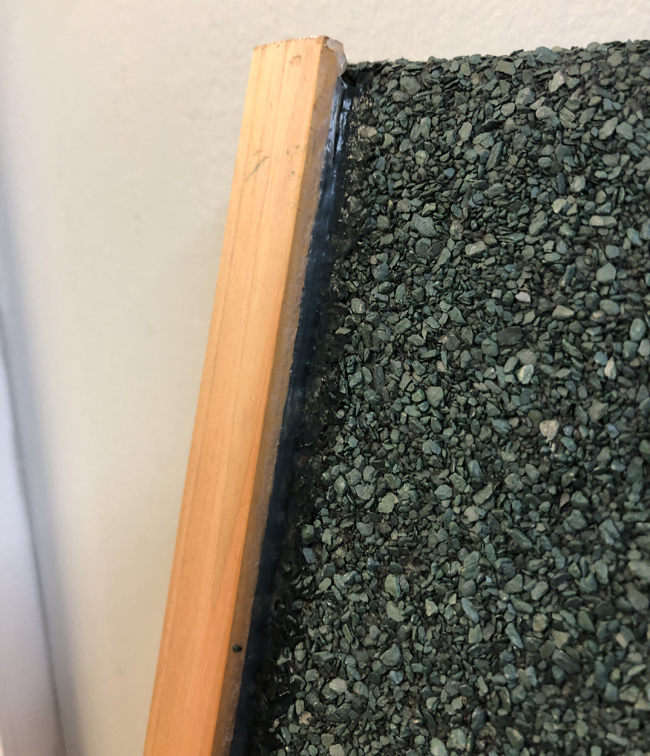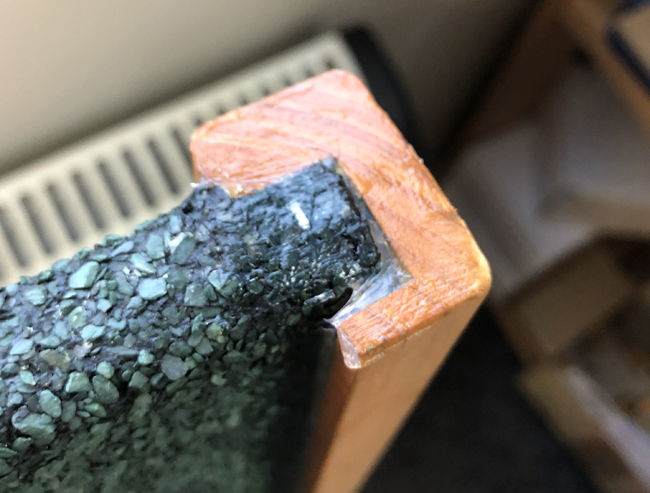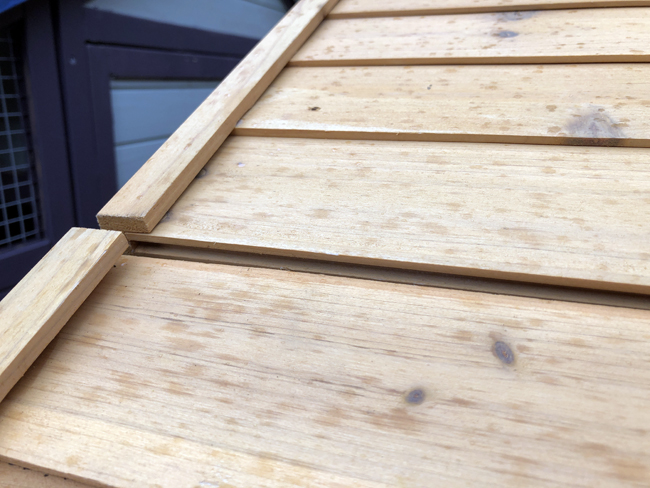Caring For Your Coop
As with most outdoor products the lifespan of your chicken coop can be dramatically prolonged just by taking a few extra steps.
Below are some recommendations that we suggest you seriously consider taking to ensure the longevity of your coop or run as well as the safety of your pets.
Recommendation 1 : Treating the wood
Your coop and or run has been treated with a base coat of wood preservative.
While the wood we use for the majority of our products is highly durable and resistant to decay and rot, we do recommend that you consider treating the outside of your coop or run with a high-quality varnish or wood preservative.
We also suggest applying a coat to the underside of the roof panel.
We recommend that you consider treating your coop once a year (preferably before the winter season) to maintain the applied preservative and water repellent properties.
If you choose not to do so then over time the base coat we have applied will fade and your product may not look as good!
Treating your coop and run with a coat of Cuprinol or Ronseal will help prolong the life of the coop, possibly giving you a year or two extra of use.
So it really is time well spent and worth the effort.

Recommendation 2 : Lubricate metal parts.
It would be beneficial to occasionally spray the locks and stays with products like WD-40 to keep the metal lubricated.
If you choose not to do so then you may find that the stays seize and can result in you damaging the coop roof when you try to open it.
We recommend once a month applying a small amount on the stays (if your coop has them), locks and hinges to ensure that these metal on metal parts continue to work smoothly.
Please do take care and ensure your pets are not inside the coop or run while you do this. Wipe away any excess lubricant if needed.
Recommendation 3 : Positioning your coop.
We highly recommend that you try and position your coop in a protected area which is not overly exposed to the elements and protected at all times from high winds (or gusts).
Every year in the UK we have a few very strong storms that bring high winds which could possibly result in your coop being blown over or even the roof being blown off.
Apart from the damage that these high winds could cause to your coop don't forget that your hen may be inside at the time!
When setting up your coop, try and position it so that any doors are not facing directly into driving rain as it is possible with the 'right conditions' that rainwater is blow in under the doors.
Recommendation 4 : A regular cleaning regime
We recommend that you clean your coop out regularly (once a week) making sure to thoroughly wipe down and disinfect the insides of it.
Always use a good disinfectant when cleaning your coop or run. Some natural cleaning products may be worth considering too.
Make sure that there is adequate air circulation at all times around the entire coop otherwise, there will be an increase in the likelihood of mould build-up.
Replace any wet or soiled bedding and hay. In addition, you should aim to remove droppings every day if there is a build-up.
Over the colder, damper months, mould can form on the insides of your coop if there is not adequate ventilation. (This can be exacerbated by keeping the coop covered or preventing good air circulation.)
Mould can spread quickly if it's not treated immediately.
By regularly cleaning and disinfecting your coop or run as well as making sure there is adequate ventilation inside and out you greatly reduce any chance of the naturally occurring air bourne mould spores from taking hold and growing.
Recommendation 5 : Stop capillary action
During periods of prolonged wet weather, rainwater can be drawn in and around the decorative edges of the roof panels by capillary action.
This can cause damp patches to appear near the edges on the underside of the roof and nesting box which can lead to a build-up of mould and reduce the lifespan of the roof panel.
To greatly reduce this natural phenomenon we recommend running a thin bead of clear silicone between the top of the roof panels and the decorative edging.
If done correctly, this creates a clear barrier that stops the rainwater from being drawn in under the edging and so stops capillary action.
Taking these quick and simple extra steps will prolong the lifespan of the roof panels which tend to be the part of the coop that will experience the full force of nature throughout the years.
You can order good quality silicone suitable for outdoor use from Amazon for under a fiver. Many people have told us that they have used this brand of silicone which great success.
If you are using silicon on the Dorset or Kent Coop then we recommend this brand.
The photos below will give you an idea of where to locate a thin bead of silicon.
![]()
Run a bead in between the little gap on the underside of all the decorative edges and the roof panels and nesting box lid.
![]()
Once applied use a wet finger to smooth out the bead, pushing the silicone into the gap between the edging and the roof.
![]()
It's also a good idea to put some silicone on the ends of the nesting box lid and roof panels too.
![]()
Once smoothed over it creates an invisible barrier between the joints.
The same can be done with the Dorset's roof as shown below. We recommend a specialised bitumen friendly sealant. See recommendation above.


Run a bead of silicone/sealant on the underside of the roof panel to stop capillary actions

The main roof of the Sussex comes in two sections which are fitted together.

Run a bead of silicon between the joints and smooth over with a wet finger to create a clear waterproof barrier.
![]()
Recommendation 6 : A WARNING ABOUT FOXES!
If you are going to keep your chickens then you need to be aware that foxes are a real threat. Every year people lose their much-loved hens to foxes.
We highly recommend that you read our recommendations on how to safeguard their welfare against foxes and other animals (dogs, badgers, cats).
Full details can be found here: Fox proofing a chicken coop.
We would like to think that our products are made to a higher standard than most other suppliers in our price range.
While we have purposely used thicker, sturdier wood, wire and locks with the aim to make it as safe and secure as possible for your pets we cannot guarantee that foxes, badgers, dogs and even cats won't try and forcefully gain access.
We do not pretend that our products are 100% predator proof and we don't make false claims (like some of our competitors) that they are.
Preditors like foxes/dogs/badgers are by far the biggest threat that your pet will face so if you are going to keep your rabbits or guinea pigs outside then we also urge you to take these added precautions.
Please don't be complacent! Foxes are powerful and persistant preditors.

